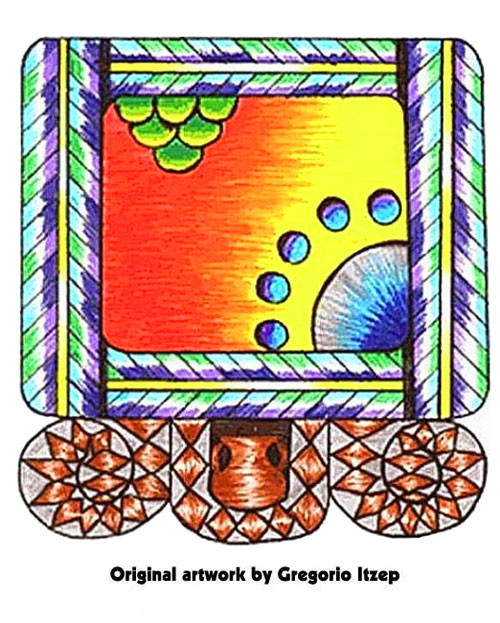
Cauac Trecena
by Kenneth Johnson
You may have seen it written, in various Aztec or Yucatec sources, that Cauac is a difficult energy. And sometimes it is. But we need to see this in its proper context. And the context here is a social one. The difficulties and misunderstandings symbolized by Cauac are those which set us apart from the larger community. In the K’iche’ language, the bond that unites us with community is called awas. When we lose the connection with awas, we lose the sense of community. The Maya would never perceive someone who lives in a cave and fasts as “spiritual”; they would regard such practices as anti-social. In the words of the English poet John Donne, “No man is an island.” We are all connected. At its best, Cauac is the spirit of that connectedness. Cauac is the universal community.
At the very heart of any community is the home and the family. The wife and/or mother is the very heart of the household. The sense of community and communion is founded in the feminine principle. In fact, in the Yucatec language, the words for “home” and “mother” are the same; only context distinguishes between using the word na to mean a house or the mother who abides in it. Since hearth and home are the center of any community, whether small or planetary, Cauac may be taken as the day-sign of the Eternal Feminine. It is strongly associated with idwives and female healers; it is their special day, and a day of women in general. The traditional garments (traje) worn by Mayan women are sometimes taken as yet another image or symbol for this day-sign.
Some daykeepers have told me that Cauac is symbolic of the first great offering performed by the four Jaguar Fathers at the dawning of the Fourth World. Hence it symbolizes the kind of sacrifice, the kind of union with others through which we may most easily achieve our own personal sunrise, the end of our troubles and travails. Cauac takes us outside ourselves and reminds us of the unity of humankind.
Since this day is associated with midwifery, it is likewise associated with childbirth. It is sometimes believed among the Maya that the midwives of ancient time used quartz crystals as divinatory instruments to see within the mother’s womb and judge the growth of the fetus; the hieroglyph for this day-sign may be a kind of portrait of the developing child. In that sense, this supposed sign of “difficulties” is one of the most positive signs of all, for it symbolizes both the miracle of birth and the Feminine Principle which makes birth possible.
Cauac is also linked symbolically with an energy called the koyopa. In common speech, koyopa refers to “sheet lightning” of the type which flickers above mountains and lakes. But this phenomenon of the natural world has its correspondence within the human body; koyopa can also mean “the body lightning” or “the lightning in the blood.” Spiritual seekers who have spent time among the Maya have drawn attention to the close correspondence between the Mayan concept of koyopa and the Sanskrit kundalini. Both are connected with serpent imagery. Yogic texts describe the kundalini as the “serpent power.” Bolts of lightning are regarded by the Maya as “sky serpents.”
The koyopa is an energy upon which shamans draw for divination ritual in which the daysigns of the tzolk’in are represented by groups of seeds from the sacred tz’ite tree. A shaman’s hand may literally shake with the power of koyopa as he holds it over the divining seeds. (I have actually seen this.) Sometimes the koyopa “awakens” as a pulsing in one’s leg or other limb.
The koyopa, like the kundalini, is essentially feminine and is associated with the 13 numbers. Koyopa collects in the thirteen major joints of the human body, which thus form a Mayan analogy to the chakras. It is from one of these thirteen points that the pulsing and hand trembling will have their origin.
Upon this day, we may pray that there will always be harmony in our home lives and among our friends. Cauac is auspicious for all matters regarding health and healing, especially healing modalities associated with women’s wisdom such as herb-lore and midwifery. This is the day associated with quartz crystals and their healing power. Like Caban, it is one of the days which is strongly linked with the tz’ite seeds used in the Mayan divination ritual.
http://www.jaguarwisdom.org

